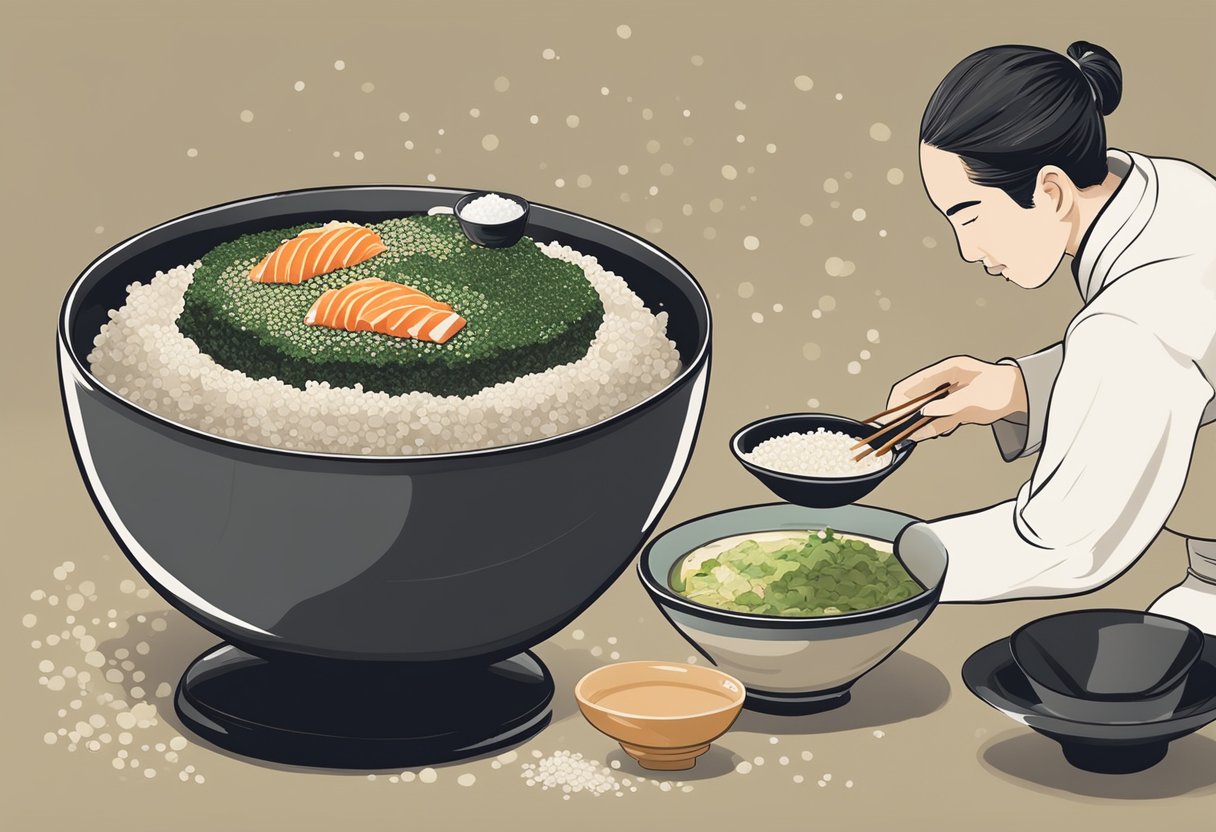Nori is a type of edible seaweed that has been a staple in Japanese cuisine for centuries. It is commonly known for its role in sushi preparation, where it acts as a wrapping for rice and other ingredients. The cultivation of nori is a refined process that involves the careful harvesting of algae, which is then dried and formed into thin, delicate sheets.
This seaweed is not only valued for its unique flavor and texture but also for its nutritional benefits. Rich in proteins, vitamins, and minerals, nori is often considered a health food. It is also versatile, used in various dishes beyond sushi, such as snacks, seasoning, and as a garnish. The appreciation for nori has spread globally, and it can now be found in many different forms in markets around the world.

Key Takeaways
- Nori is an integral component of sushi and a nutritious seaweed extensively used in Japanese cuisine.
- Contains a multitude of vitamins and minerals, contributing to its recognition as a health-promoting food.
- Nori's global presence has increased, with diverse culinary applications and availability in various forms for consumers.
Origins and History

Nori refers to the edible seaweed species of the red algae genus Pyropia, including P. yezoensis and P. tenera. It is widely used in Japanese cuisine, principally as a wrap for sushi and onigiri. Nori's cultivation dates back to the 17th century in Tokyo Bay, Japan.
Early History:
- 8th Century: Earliest written records in China
- 17th Century: Beginning of Nori cultivation in Japan
Development in Japan:
- Initially, nori was harvested from the wild, but the farming technique started around the Edo period in Japan, particularly in Tokyo Bay.
- During the Edo period, the framing technique involved bamboo poles, which were replaced with nets after World War II.
Advancements:
- The transition to the use of nets allowed for mass production.
- In the 20th century, a decline in nori production was addressed by a critical scientific discovery by British Phycologist Kathleen Mary Drew-Baker, which led to understanding the lifecycle of nori, thereby aiding in industrial farming.
Culinary Integration:
- Nori became a staple in Japanese cuisine and a significant agricultural product.
- Sushi, Onigiri, and Temaki are classic dishes that commonly incorporate nori.
Today, Japan remains a leading producer of nori, alongside South Korea and China, who have also adopted nori cultivation methods. The knowledge and techniques of nori production have been refined over generations, making it an integral part of the culinary traditions of East Asia.
Types and Varieties

Nori is a term commonly used to describe edible seaweed species, mostly belonging to the genus Pyropia, including Pyropia yezoensis and Pyropia tenera. It comes in several forms, distinguished by qualities such as texture, flavor, and cultivation method.
-
Ajitsuke Nori: Seasoned with a mixture of soy sauce, sweeteners, and sometimes sesame seeds or other flavorings. It is often used in rice balls or as a snack.
-
Yaki Nori: Roasted nori, typically used for wrapping sushi rolls. It is known for its crisp texture and umami flavor.
Grades of Nori Nori is also categorized by grades, mainly based on color, shininess, thickness, and flavor.
| Grade | Characteristics |
|---|---|
| Gold | Top-quality, very flavorful, and a vibrant green |
| Silver | Slightly lower quality than gold but still prized |
| Blue | Everyday quality, less uniform in texture |
| Green | Lesser grade, used for soups and similar dishes |
The cultivation of nori is also a key aspect that affects its varieties. The two primary methods are:
-
Natural Cultivation: This method relies on the natural growth of nori in coastal areas. The variety produced typically has a stronger oceanic flavor.
-
Farming: The majority of nori is now farmed, involving the seeding of nets which are then placed in the ocean. The farmed nori is harvested in a controlled manner, which allows for more consistent quality and texture.
Different varieties are used in various culinary applications, from garnishes on noodle dishes and soups to an essential component of onigiri and sushi. The specific type chosen often depends on the intended use and the desired sensory attributes in the final dish.
Culinary Uses

Nori, a versatile seaweed, is widely utilized in various culinary applications due to its unique flavor and nutritional benefits.
Sushi and Rolls
In the context of sushi preparation, nori serves a foundational role. Sheets of nori are commonly used to encase sushi rice and fillings, forming what is known to many as maki sushi. For example:
- Hosomaki: Thin rolls with rice on the inside, wrapped with nori.
- Futomaki: Thick rolls that often include multiple fillings, bound by a nori exterior.
- Temaki: Conical hand rolls where nori forms a cone filled with rice and other ingredients.
Another sushi variant, nigiri, occasionally features a thin strip of nori tying the topping to the rice.
Seasoning and Garnishes
Nori isn’t limited to sushi; it's also transformed into flavorful seasonings and garnishes. Examples of these include:
- Furikake: A dry Japanese seasoning sprinkled over rice, which often contains crushed nori.
- Aonori: A powdered form of nori applied to dishes like okonomiyaki and yakisoba for a burst of oceanic flavor.
In its whole or shredded form, nori adds color and a crisp texture to dishes such as:
- Rice Bowls (Donburi): Garnished with strips of nori, enhancing both the visual appeal and taste.
- Noodle Soups: Small pieces of nori are floated atop to provide an umami boost.
Through these culinary uses, nori demonstrates its indispensable role in Japanese cuisine and beyond.
Nutritional Profile

Nori, a dried seaweed often used in Japanese cuisine, is both low in calories and rich in nutrients essential for maintaining good health.
Vitamins and Minerals
Nori is a potent source of various vitamins, particularly vitamin A, vitamin C, and vitamin B12. It also contains a significant amount of minerals such as iodine, which is crucial for thyroid function, as well as calcium, magnesium, and iron. Here's a brief overview:
- Vitamin A: Important for vision, immune function, and skin health.
- Vitamin C: An antioxidant that aids in tissue repair and enzyme function.
- Vitamin B12: Essential for nerve health and the production of DNA.
- Iodine: Key for thyroid hormone production.
- Calcium: Vital for bone health.
- Magnesium: Involved in over 300 biochemical reactions in the body.
- Iron: Necessary for the formation of red blood cells.
Dietary Fiber
The dietary fiber content of nori is impressive, considering its low-calorie profile. Fiber is integral to digestive health and can aid in preventing constipation. Additionally, nori contains soluble fiber, which can help in managing cholesterol levels and stabilizing blood sugar levels. Each sheet of nori contains approximately 1 gram of dietary fiber.
Health Benefits

Nori, a type of seaweed commonly used in Japanese cuisine, offers several health benefits due to its nutrient-rich profile.
Weight Management
Nori is low in calories yet high in dietary fiber, which can aid in weight management. Fiber helps to promote a feeling of fullness, potentially reducing overall calorie intake. Moreover, nori's iodine content supports thyroid function, which regulates metabolism.
Heart Health
Nori contains omega-3 fatty acids, specifically eicosapentaenoic acid (EPA), which are beneficial for heart health. These fatty acids can help to lower the risk of heart diseases by reducing inflammation and potentially decreasing blood cholesterol levels. Additionally, nori is a source of potassium, a mineral that helps to manage blood pressure.
Production and Processing

Nori is traditionally cultivated in the coastal areas of Japan, where its production involves specialized techniques and stages, focused primarily on harvesting and post-processing which includes drying and toasting.
Harvesting
Nori cultivation begins with the selection of Porphyra spores that are attached to nets submerged in the ocean. When these spores mature into nori, they form thin, dark sheets. Harvesting typically takes place from November to February when the seaweed reaches an optimal size and thickness. Harvesters use boats equipped with specialized tools to carefully collect the nori from the nets without damaging the delicate sheets.
Drying and Toasting
After harvesting, nori undergoes a meticulous drying process. The sheets are washed in fresh water to remove salt and impurities and then passed through a series of rollers to achieve uniform thickness. They are then air-dried, a step that is crucial to maintaining nori's flavor and color. The final stage is toasting, which crisps the sheets and enhances their taste. Toasting occurs at a specific temperature that is carefully controlled to prevent burning. Once toasted, nori is cut into standard sizes and packaged for distribution.
Environmental Impact
Nori, an edible seaweed commonly used in Japanese cuisine, has a notable impact on the environment, both positive and negative. In terms of positive effects, nori cultivation benefits marine ecosystems:
- Carbon Sequestration: Nori grows by absorbing CO2, which can help mitigate climate change.
- Habitat Creation: Nori farms provide habitats for marine organisms, enhancing biodiversity.
- Water Quality: It utilizes nutrients in the water, which can reduce eutrophication.
On the negative side, nori production can also lead to ecological concerns:
- Monoculture Risks: Large-scale nori farms can displace diverse ecosystems, creating monocultures.
- Resource Use: Intensive farming requires significant resources, including clean water and substrates.
When assessing the environmental impact of nori, it's crucial to consider sustainable farming practices:
- Location: Choosing sites with minimal ecological disruption.
- Harvesting Methods: Ensuring non-destructive techniques.
The balance of these factors shapes the overall environmental footprint left by nori cultivation.
Buying and Storage Tips
When purchasing nori, look for packs with a vibrant green, almost black, color. Quality nori should have a uniform texture and be free from tears or holes. It is typically sold in sealed packages to maintain its crispness. Once opened, keep nori in an airtight container away from moisture and light. This will help prevent it from becoming soggy.
Here’s how to ensure nori retains its quality:
- Expiration Date: Check the pack for the expiration date. Nori can lose flavor over time.
- Storage Location: Store in a cool, dry place. A pantry or a cupboard away from any heat source is ideal.
- Refrigeration: For longer-term storage, refrigeration can help. Seal it properly to keep out moisture.
- Desiccants: Use silica gel packets to absorb any excess moisture in storage.
Checking for Freshness
- Color and Smell: Fresh nori should not have a fishy smell and should maintain its deep color.
- Crispiness: It should be crisp and crackle when bent.
To maintain freshness, use it within a few months of purchase. If nori does become damp, it can be briefly toasted over an open flame or in an oven to restore crispness. However, be cautious not to burn it, as it is delicate and toasts quickly.
Frequently Asked Questions
Uncovering the specifics of nori, these commonly asked questions shed light on its health properties, unique characteristics, culinary uses, availability, and its sensory contribution to dishes.
What are the health benefits of consuming nori?
Nori, a type of edible seaweed, is packed with essential vitamins and minerals. It contains high levels of vitamin C, iodine, and fiber, and is also rich in protein. Regular consumption can contribute to improved thyroid function, digestive health, and a boosted immune system.
What are the primary ingredients used to make nori sheets?
Nori sheets are made almost exclusively from a type of red algae, usually the species Porphyra. These algae are processed into a paste, spread thinly over screens, and then dried to create the final product.
What distinguishes nori from other types of seaweed?
Nori is distinct from other seaweeds primarily due to its processing into thin, dried sheets. This method preserves the seaweed's flavor and nutrients, making it different from other thicker or granulated seaweed products.
How can nori be used in culinary applications besides ramen?
Nori is versatile beyond ramen; it can be used as a wrap for sushi, cut into strips for salads or soups, or even toasted and seasoned to create a savory snack. Its crispy texture and umami flavor enhance a variety of dishes.
Where can one purchase nori, and what are the typical price points?
Nori can be purchased at Asian supermarkets, health food stores, some regular grocery stores, and online. Prices vary depending on quality and brand, ranging from economical options to premium artisanal sheets.
What does nori bring to a dish in terms of flavor and texture?
Nori adds a distinct umami flavor which deepens the taste profile of a dish. Texturally, it provides a crisp contrast when used fresh or a softer inclusion when mixed into wet dishes.




